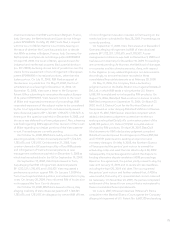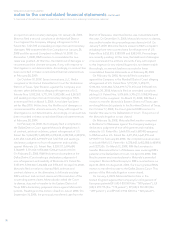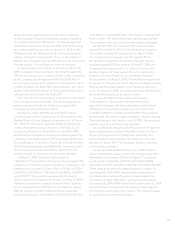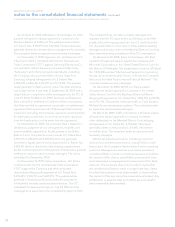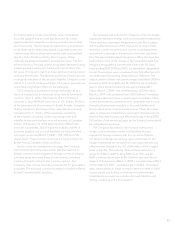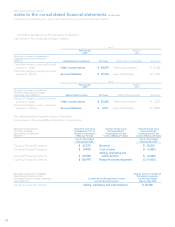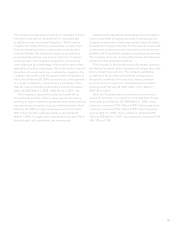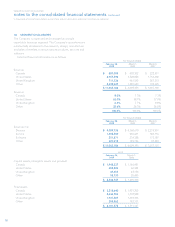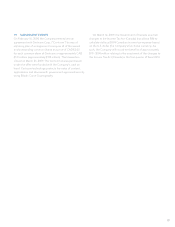Blackberry 2009 Annual Report Download - page 85
Download and view the complete annual report
Please find page 85 of the 2009 Blackberry annual report below. You can navigate through the pages in the report by either clicking on the pages listed below, or by using the keyword search tool below to find specific information within the annual report.83
The Company has entered into forward contracts to hedge
exposures relating to foreign currency anticipated transactions.
These contracts have been designated as cash flow hedges,
with the effective portion of the change in fair value initially
recorded in other comprehensive income and subsequently
reclassified to earnings in the period in which the cash flows
from the associated hedged transactions affect earnings. Any
ineffective portion of the change in fair value of the cash flow
hedges is recognized in current period earnings. For fiscal
years ending 2009, 2008 and 2007, the derivatives designated
as cash flow hedges were considered to be fully effective with
no resulting portions being designated as ineffective. The
maturity dates of these instruments range from March 2009 to
November 2010. As at February 28, 2009, the net unrealized
loss on these forward contracts was approximately $2.7
million (March 1, 2008 – net unrealized gain of $34.6 million;
March 3, 2007 – net unrealized loss of $7.8 million). Unrealized
gains associated with these contracts were recorded in Other
current assets and Accumulated other comprehensive income.
Unrealized losses were recorded in Accrued liabilities and
Accumulated other comprehensive income. These derivative
gains or losses are reclassified to earnings in the same period
that the forecasted transaction affects earnings. In fiscal 2010,
$1.2 million of net unrealized gains on the forward contracts will
be reclassified to earnings.
The Company has entered into forward contracts to
hedge certain monetary assets and liabilities that are
exposed to foreign currency risk. For contracts that are
not subject to hedge accounting, gains and losses on the
hedge instruments are recognized in earnings each period,
offsetting the change in the U.S. dollar value of the hedged
asset or liability. The maturity dates of these instruments
range from March 2009 to May 2009. As at February 28,
2009, a net unrealized gain of $16.0 million was recorded in
respect of this amount (March 1, 2008 – unrealized loss of $6.9
million; March 3, 2007 – unrealized gain of $542). Unrealized
gains associated with these contracts were recorded in Other
current assets and Selling, marketing and administration.
Unrealized losses were recorded in Accrued liabilities and
Selling, marketing and administration.
For the Company’s trade receivables, other receivables,
accounts payable and accrued liabilities, the fair values
approximate their respective carrying amounts due to their
short maturities. The fair value of investments is determined
using observable market data based on quoted prices and
interest rates. Where observable market data is unavailable
due to a lack of trading activity, the Company utilizes
internally developed models to estimate fair value. The fair
value of currency forward contracts has been estimated using
market quoted currency spot rates and interest rates. The
fair value of long-term debt has been estimated using market
quoted interest rates. The estimates presented herein are not
necessarily indicative of the amounts that the Company could
realize in a current market exchange. Changes in assumptions
could have a significant effect on the estimates.
The Company is exposed to foreign exchange risk as a
result of transactions in currencies other than its functional
currency, the U.S. dollar. The majority of the Company’s
revenues in fiscal 2009 are transacted in U.S. dollars. Portions
of the revenues are denominated in British Pounds, Canadian
dollars, and Euros. Purchases of raw materials are primarily
transacted in U.S. dollars. Other expenses, consisting
of the majority of salaries, certain operating costs and
manufacturing overhead are incurred primarily in Canadian
dollars. At February 28, 2009 approximately 36% of cash
and cash equivalents, 26% of trade receivables and 4% of
accounts payable and accrued liabilities are denominated
in foreign currencies (March 1, 2008 – 13%, 35% and 15%,
respectively). These foreign currencies primarily include the
British Pound, Canadian dollar, and Euro.
As part of its risk management strategy, the Company
maintains net monetary asset and/or liability balances in
foreign currencies and engages in foreign currency hedging
activities using derivative financial instruments, including
currency forward contracts and currency options. The
Company does not use derivative instruments for speculative
purposes. The principal currencies hedged include the British
Pound, Canadian dollar, and Euro.




